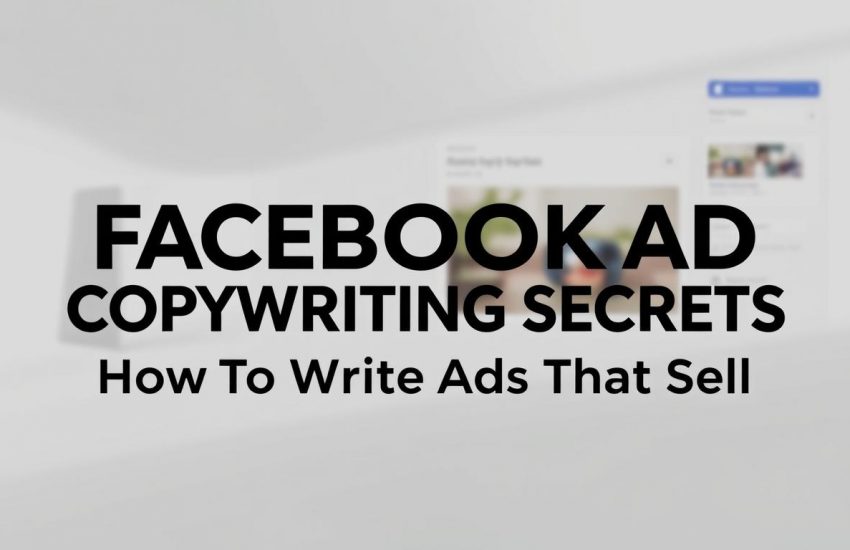We have stood where you stand now — staring at a campaign dashboard and hoping words will move people to act.
On a platform with nearly 2.91 billion monthly users, our challenge is simple and urgent: earn attention fast. The first 125 characters of primary text must hook a reader before the “See more” cutoff, because the average person sees over 1,700 banner ads every month.
This guide is a practical playbook. We show step-by-step methods that pair smart copy with aligned creative and precise targeting to drive real results.
We promise frameworks for awareness stages, testing plans, and mobile-first best practices. By the end, we will give you reusable templates and data-backed ranges so our audience can craft ads that sell — not just get likes.
Key Takeaways
- Hook readers in the first 125 characters to beat truncation.
- Stand out: users face 1,700+ ads monthly, so clarity wins.
- Align copy, creative, and targeting to convert, not just engage.
- Follow a step-by-step guide with testing and mobile-first rules.
- Use data-backed limits and examples to build repeatable campaigns.
Why Facebook Ad Copywriting Matters Today
When organic channels slow, targeted paid campaigns become the primary growth engine.
Traffic flows from three main sources: organic (SEO, social, content), referral (partners, endorsements), and paid (facebook ads, display). Organic reach has fallen, so paid distribution matters more for getting timely information in front of the right people.

Traffic sources and why paid matters
Paid wins when precision beats reach. The platform’s targeting depth—custom audiences, interests, behaviors—lets us place the right content before the right users.
From noise to notice
Users see over 1,700 ads each month. People scroll fast, so every line must offer clear value in little time. Great creative can attract attention, but words set expectations and move users to act.
- Define audience and objective first.
- Write to one person with precise information.
- Test hooks and iterate quickly to lower CAC.
| Source | Strength | When to use |
|---|---|---|
| Organic | Trust & longevity | Brand building and SEO |
| Referral | Third-party credibility | Partnerships and endorsements |
| Paid | Speed + precision | Acquisition and testing |
Facebook Ad Copywriting
Words and visuals must work as a single machine to turn attention into action.
The core components
Primary text is the top line where the hook must land. The first 125 characters matter most because they are seen before truncation.
Creative (an image or video) does the heavy lifting for attention. It must reinforce the promise in the text and match the mood of the headline.
The headline sits below the creative on the platform and acts as a secondary hook. Keep it clear and benefit-led to capture skimmers.
The description is the small line under the headline. Use it for one complementary point — not a repeat — to add value without crowding the view.
Pick a CTA button that matches the funnel step (Shop Now, Learn More, Sign Up). A tailored button reduces friction and improves conversion.

Placements and message depth
- Sponsored Posts: integrate into the feed — ideal for story-driven, multi-line text and richer images or video.
- Right-hand column: smaller, fixed, and strong for retargeting and short reminders.
- Map complexity to placement: longer narratives in feed, concise offers in the column.
“Treat each component as its own tiny conversion funnel; together they move users down the path.”
Checklist tip: document primary text, creative type, headline, description, and CTA for every build so nothing is missed.
Set Your Strategy: Targeting the Right Audience Before You Write
We always lock the target customer first, then let that guide tone and offer. A clear strategy saves budget and sharpens every line of copy.
Dialing in targeting: custom lists, interests, behaviors
Start with Custom Audiences — customers, leads, and website visitors. Layer Location, Gender, interests, and Behaviors to narrow reach.
Write to one persona
We write as if speaking to a single person. Document their pain, desire, and language. That makes the message feel personal and real.
Segmented campaigns for better results
Run separate campaigns for first-time buyers, past purchasers, and warm prospects. Exclude purchasers to cut waste.
- Interest stacking (e.g., fitness + women 30+ + U.S.) refines who sees an ad.
- Map content depth: retargeted visitors get direct offers; cold leads get education.
- Set small test budgets per segment to learn fast.
| Audience | Trigger | Landing page goal |
|---|---|---|
| Custom: past purchasers | Repeat purchase offer | Simple checkout page |
| Interest: fitness women 30+ | Activewear promo | Benefit-led product page |
| Website visitors (30 days) | Limited-time discount | Personalized product page |
“Document each segment’s problem, desired outcome, and objection to guide our copy.”
Craft the Hook: Win the First 125 Characters
We have one short line to earn a tap. The first 125 characters of primary text decide whether users stop or scroll. Place the hook at the top so mobile skimmers see the promise before truncation.
Open loops work. Use curiosity phrases like “discover why” or a sharp statistic that creates a gap the reader wants closed. Questions such as “Tired of X?” pull readers into the rest of the text.
Keep the opener specific and singular. One strong idea beats a cluttered sentence. Make sure the first phrase stands alone if the rest is hidden.
Open loops, curiosity, and question/statistic/shock hooks
- Front-load your strongest claim so attention is rewarded instantly.
- Test question hooks for relevance, statistic hooks for credibility, and shock hooks for stop-power.
- Preview the next action subtly: “See the 3-step plan” guides the reader to expand.
Mobile-first constraints: keep it punchy, scannable, and front-loaded
Write tight text that opens a loop without depending on truncated context. Use “you” to make the hook personal and urgent.
| Hook Type | When to use | Example opener |
|---|---|---|
| Question | When you know user pain | “Tired of late-night software crashes?” |
| Statistic | To add credibility fast | “90% of teams miss this one step.” |
| Shock | To stop fast-scrolling users | “You’ve been using the wrong logo size.” |
“Treat the first line as the headline for the scroll — it must promise value and be clear on its own.”
Write the Ad Body: Align Copy with Customer Awareness
We match the depth of our message to how much the customer already knows. That means the body of the copy shifts from story-led teaching to a short, direct ask as awareness grows.
Totally unaware
Educate first, then tell a story. Start with a relatable scene that surfaces the problem. Use gentle teaching and one clear example to help the reader nod and continue.
Problem aware
We empathize with the pain, introduce a simple solution, and lead with benefits the customer will feel. Use one microproof or a small case example to make the claim believable.
Solution aware
Highlight the USP, trust cues, and social proof to ease evaluation. Call out review counts, awards, or authority mentions so the reader can skip heavy research and move closer to the page.
Product aware and very aware
For product aware users, add incentives and scarcity—limited offers or short trials—to trigger action now. For very aware customers, keep it tight: confirm fit and end with a clear headline-aligned CTA.
“Structure the body to move readers from hook to proof to offer, and mirror landing page language to reduce friction.”
- Modular copy: swap segments by awareness without rebuilding the whole ad.
- Flow: hook → proof → headline-aligned offer → CTA.
Close Strong with the Stinger: CTAs that Drive Action
The closing sentence should do three jobs: remind, simplify, and direct.
We treat the Stinger as a mini-conclusion: restate the pain, name the offer, and give one clear action. Keep language plain and friendly so users know exactly what happens next.
Pair the platform button with matching copy in the Stinger to reduce friction. Use measured urgency—words like “today” or “limited spots”—only when they serve the user’s goal.
- Restate the key benefit in one short phrase.
- Tell the user the single action to take now.
- Ensure offer details match the landing page to keep trust.
“Click to claim your spot today” works because it names the offer and gives one simple task.
| Stinger Element | Purpose | Example |
|---|---|---|
| Restate pain | Reconnect urgency | Stop losing hours to manual reports |
| Name offer | Clarify value | Free 7-day trial |
| Single action | Reduce choices | Click the button to start |
Test small variations of urgency and exclusivity to see which lifts response without hurting quality. These practical tips help us close with more consistent action.
Make Creative and Copy Work Together
Visuals and words must signal the same benefit at a glance. We pick an image that confirms the headline and a short line of body copy that adds a clear next step.
On-image text is often the most-read piece of the ad. Keep it short, bold, and hook-driven so it complements — not repeats — the first line of copy.
Images and video that reinforce the message and benefit
- Show the outcome: choose images that make the benefit obvious on mobile.
- Use motion wisely: employ video when action proves value, with the opening second focused on the core promise.
- Legibility: ensure visuals read without sound and avoid overlays that compete with the main message.
On-image text: short, bold, and hook-driven
We keep on-image text minimal and aligned to the headline. Test hero-product shots versus after-state scenes to learn which way drives conversions.
Tip: match color, type, and export specs so creative looks native and sharp on the platform.
Headlines and Descriptions That Don’t Get Cut Off
A headline must promise one thing fast — then the description expands that promise. Keep both fields distinct so each line earns its place near the button and link.
Keep the headline and description distinct and complementary
Write headlines that deliver one clear promise or offer. Aim for roughly 25 characters so the main idea shows in most placements.
Use the description to add a different, supporting point. About 30 characters is a safe target to avoid truncation and to add a proof point, qualifier, or incentive.
- Headline: name the benefit or format (example: “10-Minute Stackable Workouts”).
- Description: add urgency, social proof, or a qualifier (example: “Try 3 free classes this week”).
- Avoid repeating the same copy in both fields — each wastes prime space.
Character-safe guidance for clean display
Test 2–3 headline variants that change the angle (benefit, number, format) rather than synonyms. Mirror key terms on the landing page to keep expectations aligned.
“Keep microcopy simple and scannable so readers understand the offer without expanding anything.”
Quick checklist: headline ≤ 25 characters, description ≈ 30 characters, no duplication, align with primary text, and never leave the description blank when placement allows it. Track which combos drive CTR and page conversions, not just headline clicks.
Lead with Value: Benefits, Numbers, and Social Proof
Put the outcome front and center so readers can decide fast. We open with the benefit that matters most and keep the rest compact.
Benefit-first copy that answers “what’s in it for me?”
Start with the payoff. Say the key benefit in plain language. Use short phrases that let people judge fit at a glance.
Be upfront with pricing, savings, and quantities
Show price, percent off, or stock counts early. Ball Honda-style clarity and a clear deadline remove guesswork and speed decisions.
Trust builders: reviews, testimonials, and counts
Proof matters. Use review counts, recognizable press, or endorsements to back the claim. LARQ’s “2000+ 5-star reviews” style gives instant credibility.
- Lead with one clear offer angle, not a list of perks.
- Present key numbers before the user expands the copy.
- Match the value line to the landing page for consistent brand trust.
“Getting everything done is easier than you think.” — TaskRabbit
Optimization Workflow: Test, Learn, and Scale
We treat optimization as a simple cycle: test a single variable, learn fast, then scale winners methodically.
A/B testing hooks, value props, and CTAs
Set up clean A/B tests that isolate one variable at a time—hook, value prop, or CTA—so we know what truly moved people to take action.
We hold creative constant using platform tools while swapping headlines or CTAs. Small copy tweaks can drive outsized results; Post Planner’s tests show a question vs. statement can change performance meaningfully.
Audience splits: creative holds, copy changes
Split the same audience to test copy across segments. Keep imagery fixed so differences come from words, not visuals.
Use right-hand column placements for retargeting checks and Sponsored Posts to evaluate hooks and value props at scale.
Reading results: engagement vs. down-funnel conversions
Compare engagement cautiously. The real measure is down-funnel conversions—leads and purchases—not just clicks.
Prioritize action metrics tied to our objective. Document every test in a simple log so wins are repeatable and failures are avoided.
- Scale budgets into winners gradually while continuing to iterate.
- Refresh copy to prevent fatigue on smaller pools and rotate ads in retargeting with stronger urgency.
- Share test tips with the team so top-performing patterns become our default playbook.
Mobile-First Best Practices for 2025
Most people scroll with their thumb—so our top line must land immediately.
We design for small screens: high-value text above the fold and a single clear goal per creative.
Keep primary text concise and front-loaded. Users should grasp the benefit in one glance. Trim sentences so scanning reveals the benefit, proof, and next step quickly.
Short sentences, quick scannability, and above-the-fold impact
Make sure on-image text is legible on a phone. The core point must be visible without tapping.
For video, lead with bold visual cues in the first second and add captions so the message works without sound.
“Design for mobile first: simple images, high contrast, and immediate clarity.”
- Choose images that read at small sizes and match the headline.
- Verify CTA and value prop remain visible when description truncates.
- Align mobile goal with the post-click path: fewer fields and faster time-to-conversion.
- Test landing load speed and always review the ad on a real phone before launch.
We treat these checks as part of QA so our copy and creative reach the user quickly and convert.
Compliance, Clarity, and Brand Voice
We build every message to pass platform reviews on the first try. Following advertising rules protects our account and keeps campaigns running. We write with clear, honest claims so people know what to expect.
Stay aligned with policies and approvals
We review platform advertising policies before drafting headlines or offers. We avoid prohibited language and personal attributes, and we back claims with verifiable facts.
- Keep promises realistic and document proofs.
- Add clear disclaimers when required; avoid hidden fine print.
- Create internal checklists so compliance is routine, not last-minute.
Friendly, plain language people understand
We write short, plain sentences so people grasp the offer at a glance. The tone matches our brand across creative and landing pages to reduce confusion and support issues.
“Clear information and consistent voice protect our business and build long-term trust.”
We align copywriting choices with business priorities and train stakeholders so reviews are faster and the message always matches the product experience.
Conclusion
This is the practical finish line: turn lessons into repeatable campaigns that win.
Define the audience and objective, then write facebook ads with a hook that earns attention in the first 125 characters. Match primary text to an image or video that visualizes the promise. Use a clear headline and a distinct description so nothing gets cut off.
Write to one audience at a time. Use the example patterns we cited: educate the unaware, empathize with the problem aware, prove the solution aware, and add an offer for product-aware people.
Test question vs. statement hooks, scale winners, and keep the Stinger focused on one action tied to the button. Use this guide as a repeatable process to improve marketing and business results over time.


